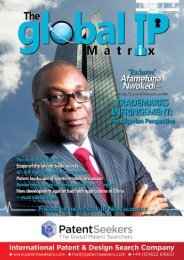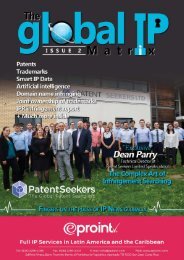Global IP Matrix - Issue 8
Dear Readers We are delighted to present you with issue 8 of The Global IP Matrix magazine! Once again, we have fantastic content delivered to you by industry professionals who are experts in their field. This issue explores IP & Innovation in Africa, anti-counterfeiting measures in the Caribbean, IPR Infringement in China, plus many more engaging articles around the IP ecosystem. It's been a challenging few months; however, we are grateful that our clients and contributors share our vision. Together, we are heading for better times. We cannot thank our authors enough for their time and efforts to keep you, our audience up to date with news and stories from their own perspective and expertise. Look out for our next edition, in January 2021 and until then, stay safe, healthy & happy. Elvin Hassan – Editor
Dear Readers
We are delighted to present you with issue 8 of The Global IP Matrix magazine!
Once again, we have fantastic content delivered to you by industry professionals who are experts in their field.
This issue explores IP & Innovation in Africa, anti-counterfeiting measures in the Caribbean, IPR Infringement in China, plus many more engaging articles around the IP ecosystem.
It's been a challenging few months; however, we are grateful that our clients and contributors share our vision. Together, we are heading for better times.
We cannot thank our authors enough for their time and efforts to keep you, our audience up to date with news and stories from their own perspective and expertise.
Look out for our next edition, in January 2021 and until then, stay safe, healthy & happy.
Elvin Hassan – Editor
Create successful ePaper yourself
Turn your PDF publications into a flip-book with our unique Google optimized e-Paper software.
Opioid Addiction
– A Patent Perspective
J. Varbanov & Partners
European and Bulgarian Patent & Trademark Attorneys
Introduction
Opioids are a broad class of drugs that interact
with opioid receptors in your cells, creating
sensations of pain relief and pleasure. Opioids
can carry the risk of changing the brain’s
chemistry, leading to tolerance, such that a
larger dosage is required to produce the same
effect. Opioid addiction can be characterised
by an almost uncontrollable urge to use
opioid drugs. It can lead to life-endangering
health problems, such as overdosing, which in
turn may cause breathing to slow or stop, and
ultimately, death. The opioid addiction crisis
is one of the foremost global health concerns
of recent years and is largely believed to be
a direct result of the overstatement of the
benefits of opioids coupled with underplaying
the risks by large pharmaceutical companies
and advocates.
Authored by Alec Griffiths, IP Manager at Patent Seekers, UK
www.patentseekers.com
Patent filing analysis
Filings for opioid addiction treatment patents appeared to undergo a rapid rise between 1999 and
2005, with an almost equally dramatic drop in filings from thereon until 2013, where filings appear
to have stabilised. In 2005 the World Health Organisation made the addition of buprenorphine as
complementary medicine to the Model List of Essential Medicines, thereby lending credibility to
buprenorphine as a treatment and its role as an opioid agonist [2]. This global legitimising of the
drug may have led to 2005 becoming the peak year for patent filings. At first glance, it would appear
to be counter-productive to decrease the rates of innovation, given the governmental outcry and
efforts in recent years, yet, patent filings have taken a sharp decline since 2005, and even more so in
the last three years. This decline could be linked to numerous efforts to combat the crisis, including;
• A decrease in opioid prescription, wherein
the U.S. opioid prescriptions have dropped
by almost 40% between 2014 and 2019[3
• An increase in other treatment methods such
as mental health approaches [4]
One of the oldest and leading IP companies in Bulgaria
Professional, cost effective services and quality advices
Areas of practice:
*IP Protection
*IP Enforcement
*Anti-counterfeiting
*Litigations
*Domain name registrations
*IP watches
PO Box 1152, BG-1000 Sofia, Bulgaria
South Park Complex, bl.1A, 2nd fl., BG-1421, Sofia, Bulgaria
Tel.: (+359 2) 986 51 25, Fax: (+359 2) 980 32 47,
e-mail: jvp@jvpatents.com
www.jvpatents.com
North America, in particular, is at the forefront
of the effort to curb this crisis, due to the United
States and Canada having the highest opioid use
rate globally. The U.S. Department of Health
and Human Services declared a public health
emergency in 2017 due to the 42,000 deaths
attributed to opioid overdose in 2016 (more
than any year prior). An estimated 40% of these
deaths were related to prescription opioids and
2000 Canadian deaths in 2015, with a fivefold
increase in prescription opioid overdose deaths
in Ontario between 1991 and 2014.
Australia has seen massive leaps in opioid
prescription rates over a short period of time,
from approximately 3 million people in 2014
to approximately 14 million by 2019. Tramadol
addiction has exploded in Africa in recent
years, adding more stress to an already overstrained
health system. Reports also indicate
that similar events may be unfolding in Asia.
Many health professionals believe that Europe
may be next in line with evidence of an increase
in the prescription of strong opioids through
the continent. Global health initiatives and
awareness campaigns have risen in recent years
in an attempt to combat this health emergency,
which was responsible for 76% of deaths from
drug use disorders in 2015. This article takes a
look at the patents behind the fight to contain
this global concern, in an effort to see what we
may learn from them.
• Placing greater emphasis on prevention
techniques and efforts [5].
2017 saw the U.S. Department of Health and Human Services declare a public health emergency; this
appears to have done little to spur innovation, or the innovation it may have spurred has yet to be
publicly seen. The figures for 2019 are likely to be greater than represented due to patent applications
that would claim that year as a priority but have yet to be published. It is difficult to predict whether
the downward trend in patent filings will continue in the coming years, given how much publicity
and emphasis has been placed on counteracting this crisis in recent years, a resurgence may be
expected. However, the number of filings in 2018 looks far from promising.
Figure 1. Worldwide opioid addiction treatment-related patent filings between 1999-2019.
www.gipmatrix.com
19












